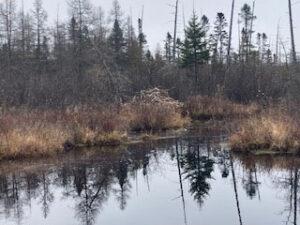Big Bad Bogs

By Homer Spit
For me, Maine bogs have always held an allure. It may be the deer hunter in me. The buck of my dreams is always seen in a bog, ghosting its way silently on the mossy ground, weaving slowly between gnarled old cedar trees and grey, weathered deadfall. There is a dusting of snow underfoot. The air has warmed creating a rising mist. Antler tips can be seen intermittently through the tree openings as the fantasy monarch moves like a cat amid the gauzy, shifting layers of fog.
Whether you are a deer hunter or not, if you have an affinity for natural wild places, a bog can be both inviting and intimidating. Inviting for the mystery of it; intimidating because it can swallow you up if you are not careful.
Orson Bog
Orson Bog just north of Brownville Junction is a case in point. Many Novembers ago, as a young deer hunter, Orson Bog and I became acquainted. Wary but fascinated, I hunted the edges of Orson Bog and a few bucks met their demise during my visits. Deer feel safe in these dark, moss-covered lowlands. For obvious reasons, many hunters won’t stay on the track when the quarry takes them into seemingly forbidden places. But it’s quiet going underfoot, for the hunted and the hunter. Once in the late afternoon I ventured too deeply into the bog and – though not really lost – found myself boxed in by standing water. Spitting snow and fading light had me worried, but eventually, through some creative compass work, the bog, with darkness coming on, lost its grip on me.
Over the years, a number of hunters have become lost or disappeared altogether in Maine bogs. In May of 2013 three people perished in Windsor Bog after their Jeep Wrangler became hopelessly stuck in the mud.. Bogs merit respect from all interlopers.
Lost Hunter
One of the most puzzling cases of a lost hunter took place Nov 18th, 1997 in Garfield Plantation a short way from Ashland. Bob Smith, 70, was hunting with is wife and never showed up at dark. What followed was one of the most extensive ground searches in Maine history. Over 300 wardens, foresters and trained search and rescue teams along with trained scent dogs found not a trace of the missing hunter, save one boot print. The next spring, teams of Game Wardens and dogs searched the various bogs and flowages and streams in the area. According to Game Warden Kale O’Leary, the search team even drained beaver dam areas looking for a trace of the missing hunter. Nothing. We may never know what happened to Mr. Smith.
Bogs all seem to have distinct features peculiar to themselves. Another of my favorites is Horseshoe Bog, which is part of the Scutaze Stream drainage. Not far from there, One Thousand Acre Bog has shared its solitude with me and some moose hunters that I have guided. Yes, these bogs hold many personal memories, some of which have been shared and some that have not.
MIchigan Bogs
Michigan has some infamous bogs, too. Outdoor writer Betty Sodders has written about the fabled Gogomain, a 25-mile square cedar swamp at the east end of Michigan’s Upper Peninsula. Betty writes: “Historically, the swamp became infamous from reports of marauding slasher bears to unstable ground bordering on quicksand that could virtually swallow up a hunter daring enough to traverse its interior. Horror stories, many most likely exaggerated, caused folks to avoid the big swamp.”
According to Betty, the big swamp is home to upwards of 1,200 wolves who take their share of Michigan whitetails. Does that make you wonder how hungry Maine coyotes find fertile hunting ground in our cedar bogs that are often wintering ground for whitetail deer?
The Great Heath in Washington County is Maine’s most high-profile bog. This protected eco-reserve comprises 5,681 acres. Geologically, it is a unique area. Called a “peatland, the Great Heath combines what is known as coastal plateau bogs and inland raised bogs. It is home for some rare wild plants, not the least of which includes: Bog Bedstraw, Canada Mountain Ricegrass, and Jacob’s Ladder . Much of this famous heath is bordered by eskers, not unlike the Whale’s Back on Route 9, not far from the Middle Branch of the Union River, itself a bog of sorts.
Black Night
On a black rainy night in November in the 1950s, my deer-hunter father got lost overnight in this area. Disoriented, he eventually figured out his location by the sight of car headlights off in the distance bobbing across this famous highway esker. After spending a long night in an overturned canoe that he found beside the river, Dad paddled his way down river and found his way back.
The borrowed canoe? I asked him that question. He returned it in time to its rightful owner. At least, that’s how the story goes.
Mane bogs are special. They do hold stories.
Homer Spit lives on a lake in Maine. He likes to keep a low profile.
For more articles about hunting, fishing and the great outdoors be sure to subscribe to the Northwoods Sporting Journal.
